INFOMARK IML-C4300W Mobile Router User Manual for iPhone 4
Infomark Co., Ltd. Mobile Router for iPhone 4
INFOMARK >
Users Manual
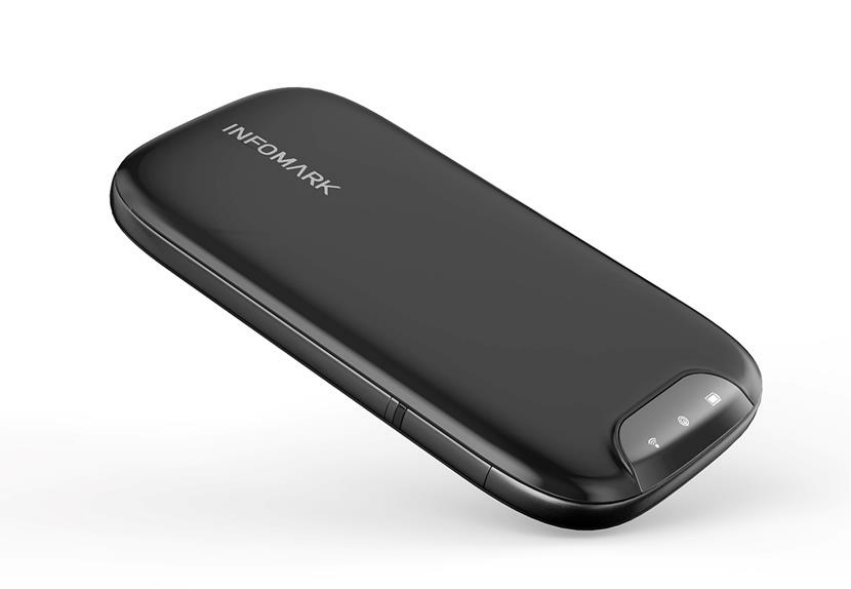
MyHotspot
User Manual
(Draft version - 2015.04.01)
Model: IML-C4300W
INFOMARK
Contents
1. Getting Started ........................................................................................................................................ 4
1.1) Your Device ........................................................................................................................................... 4
1.2) Package Contents ............................................................................................................................... 5
1.3) System Requirements ....................................................................................................................... 6
1.4) Setting Up Service .............................................................................................................................. 6
2. Device Information ................................................................................................................................ 7
2.1) Introduction........................................................................................................................................... 7
2.2) How to use ............................................................................................................................................ 7
2.3) LED .......................................................................................................................................................... 10
3. Web Management ............................................................................................................................... 12
3.1) How to Connect to Web Management Page ...................................................................... 12
3.2) Web Management Page Menu .................................................................................................. 14
3.2.1) Home .................................................................................................................................................. 15
3.2.2) Connected Devices ....................................................................................................................... 16
3.2.3) Settings .............................................................................................................................................. 18
3.2.4) Notifications .................................................................................................................................... 38
3.2.5) About .................................................................................................................................................. 39
3.2.6) Support .............................................................................................................................................. 40
4. Frequently Asked Questions ............................................................................................................ 41
5. Technical Specification ....................................................................................................................... 42
5.1) Radio Frequency specification .................................................................................................... 42
5.2) Electrical and Mechanical specification .................................................................................. 42
6. Safety Information ............................................................................................................................... 43
6.1) Important Notice .............................................................................................................................. 43
6.2) Safety and Hazards .......................................................................................................................... 43
6.3) Proper Battery Use and Disposal .............................................................................................. 44
6.4) For Your Safety .................................................................................................................................. 44
7. Regulatory Notice ................................................................................................................................ 45
8. Warranty Information ......................................................................................................................... 47
8.1) TBD ......................................................................................................................................................... 47
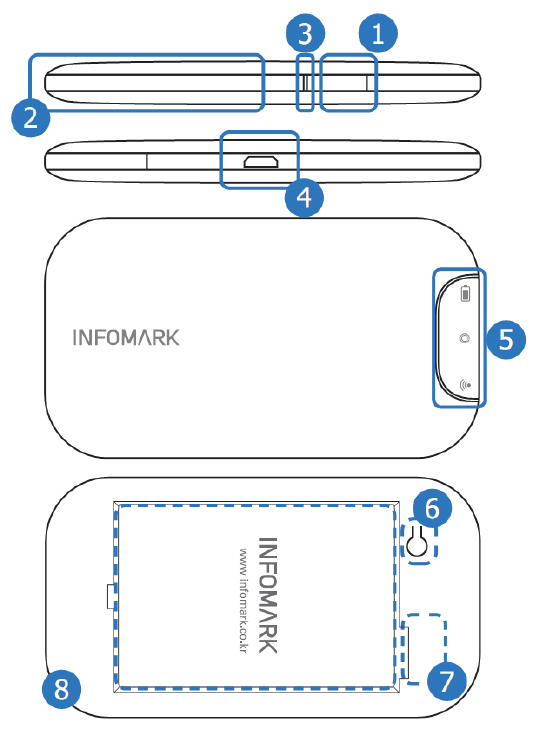
1. Getting Started
The following topics give you all the information you need to set up your device.
1.1) Your Device
1. Power button
2. Micro USB cable for charging external devices
3. Charger LED (indicates external charging status)
4. Micro USB port
5. LED indicators (Wi-Fi, Network, Power)
6. Reset button
7. Nano SIM Card Slot/Micro SD Card Slot
8. Battery
※ "6, 7, 8" is under the back cover .
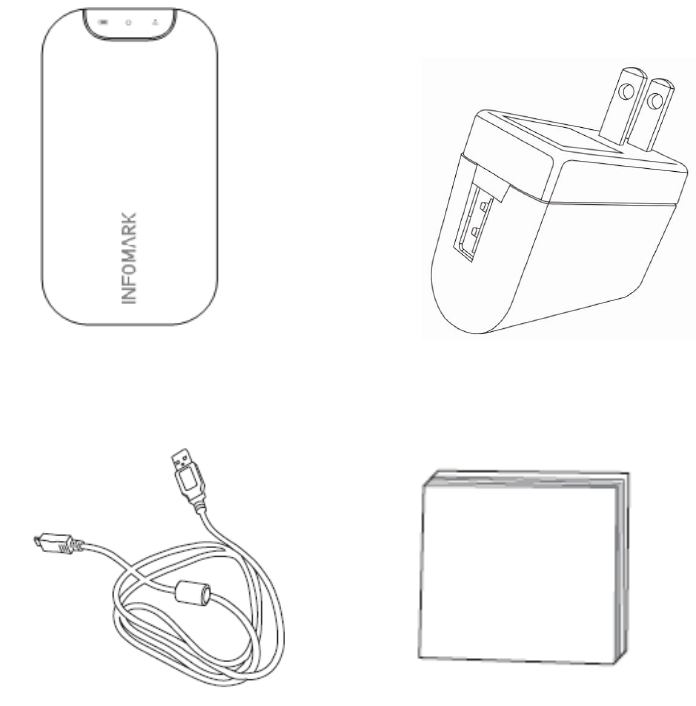
1.2) Package Contents
1. MyHotspot 2. Wall charger [5V/1A]
3. Micro USB cable 4. Quick Guide
※ Failure to use approved accessories provided by manufacturer could result in poor
performance, electric shock, fire, injury or damage to MyHotspot or other property.
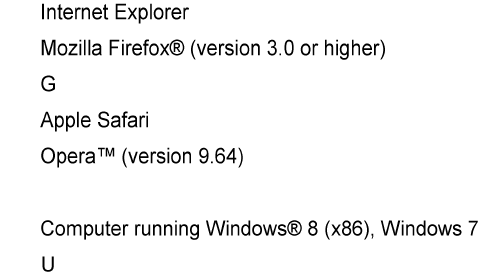
1.3) System Requirements
The following items are required to use your MyHotspot.
One or more WiFi enabled devices which support Wi-Fi (IEEE 802.11b/g/n)
Web browser. The following browsers are supported:
® (version 7.0 or higher)
oogle Chrome™ (version 2.0.172.28 or higher)
® (version 4.0 or higher)
If you will be connecting your device through USB:
or Mac OS® X (version 10.5 or higher)
SB 2.0 slot
1.4) Setting Up Service
1. Setting Up MyHotspot
- Remove the back cover.
- Insert the SIM card if not already installed.
- Install the battery.
- Install the back cover onto MyHotspot.
- Press Power button on the side of the MyHotspot for about three seconds to turn the
device on.
- Make a Wi-Fi connection from your PC or Smartphone to the device.
Default Wi-Fi SSID is "IML-C4300Wa- xxxxxx".
"xxxxxx" is the lower 6 Hex value of the Wi-Fi MAC Address.
Default Wi-Fi Key is "yyyyyyyy".
"yyyyyyyy" is the Serial number(8 Digit) of the MyHotspot.
2. Activate Your Device
- Power up your device
- Make a connection to Web management page (please refer to Section 3.3) How to
Connect to Web Management Page )
- Click 'Start Activation' on the Notification pop-up.
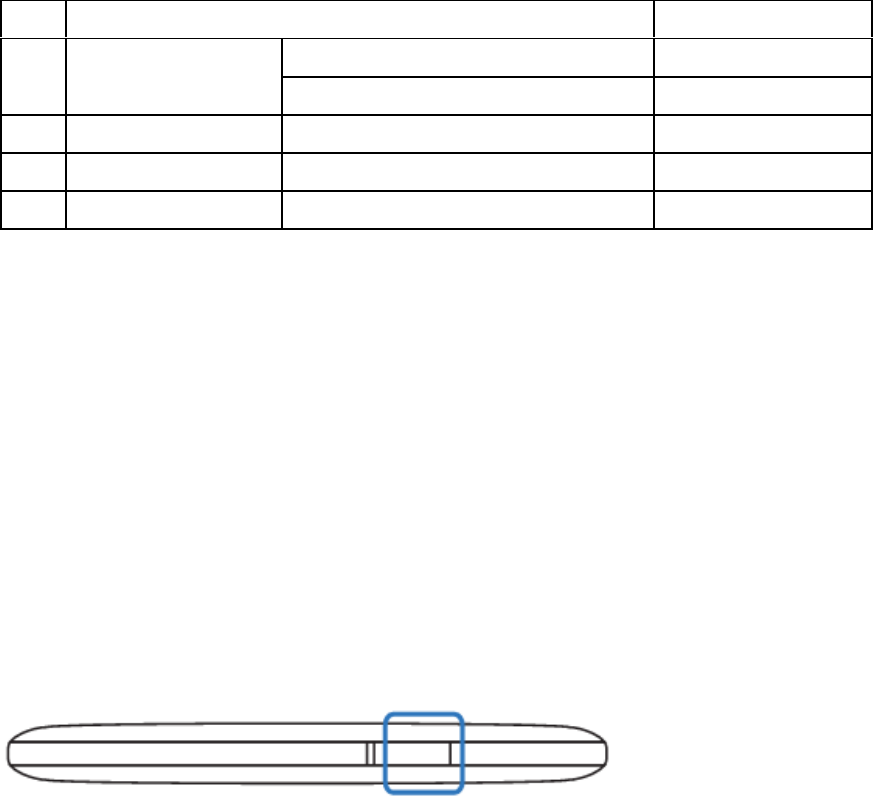
2. Device Information
2.1) Introduction
MyHotspot provide LTE service over Wi-Fi AP and up to 10 clients can connect at the same time.
※ Main Wi-Fi support up to 9 clients at the same time. To use 10 clients, Guest Wi-Fi should be
enabled. Please check the instructions in "Wi-Fi basic settings" .
2.2) How to use
The operation / battery charging time
LTE MyHotspot can be charged over wall charger or Micro USB Cable suppler provided.
No
Description
Approximate Time
1
Full Charging time
(Power off)
Over Micro USB cable.
5h 18m
Over wall charger
5h 12m
2
Operation time
Battery is full charged
7h 45m
3
Stand by time
Power On and full charged battery
8h 20m
4
Hibernation
Hibernation Mode
1000h
※ Above times may vary with the number of users, operating environment and signal
conditions.
Power
Power can be supplied through a USB cable or internal battery.
Power On/OFF
1. Power On
Push power button (more than 2 seconds) and release when PWR, Network LED is turned on
with Red color.
2. Power Off
Push power button (more than 8 seconds) and release when Network LED is Blinking with
Blue color.
Hibernation Mode
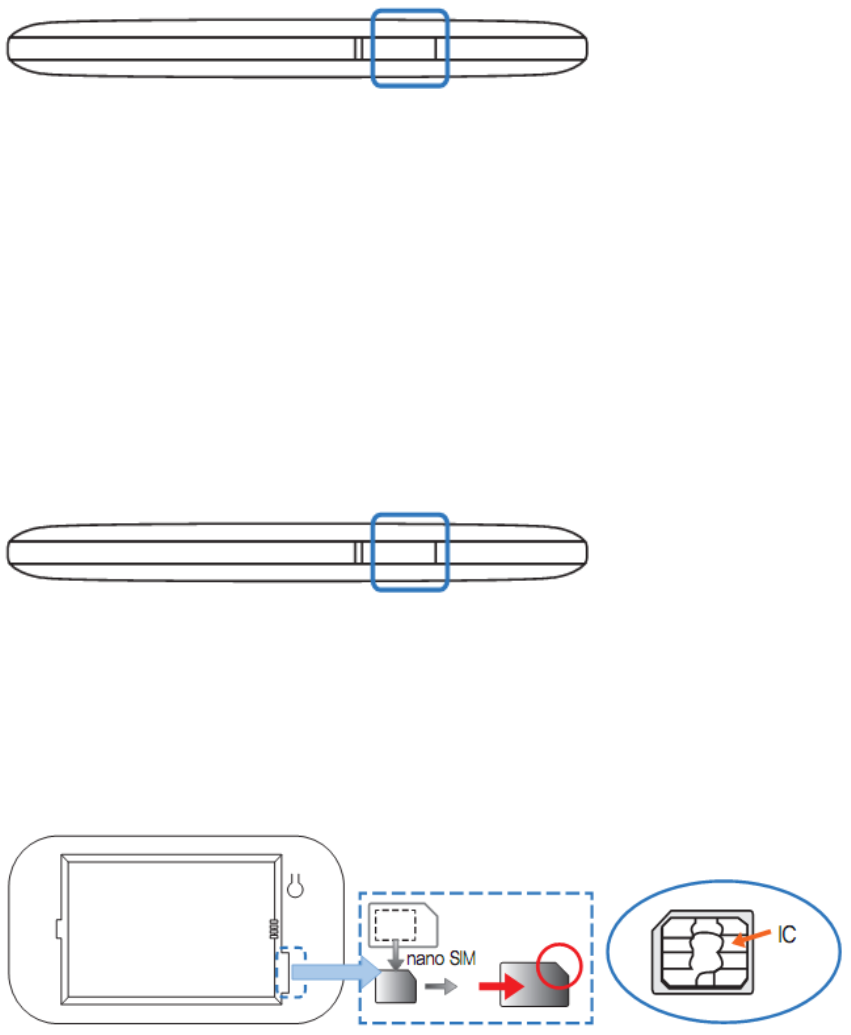
1. Wakeup
Push power button (more than 2 seconds) and release when Power LED turns Yellow,
Network LED turns Green color.
2. Hibernation Entry
Push power button (between 2~8 seconds) and release when Power LED is Blinking with
Yellow color.
※ Wi-Fi and LTE Network cannot be used in Hibernation Mode.
Device Reset
If the device is unstable or responds erratically, push the Reset Button for 1 sec to reset the
device. Reset Button is located under the back cover. Remove the back cover to find the
Reset Button.
Device Factory Reset
Factory default settings can be restored when the device is turned on.
Push power button for 15 seconds and release when Network LED is blinking with Blue color.
Wi-Fi LED turns Red. The configuration settings of the device will be reset and restored to the
factory default values. After Factory Reset, device will perform power on reset and reboot.
Nano SIM
Nano SIM card is used for LTE service.
SIM Card slot is located under back cover. First remove back cover and then insert Nano SIM
Card. There are two card slots, upper slot is for micro SD card and the lower one for nano
SIM. Before inserting SIM Card, check the card orientation. Circuit side should face down.
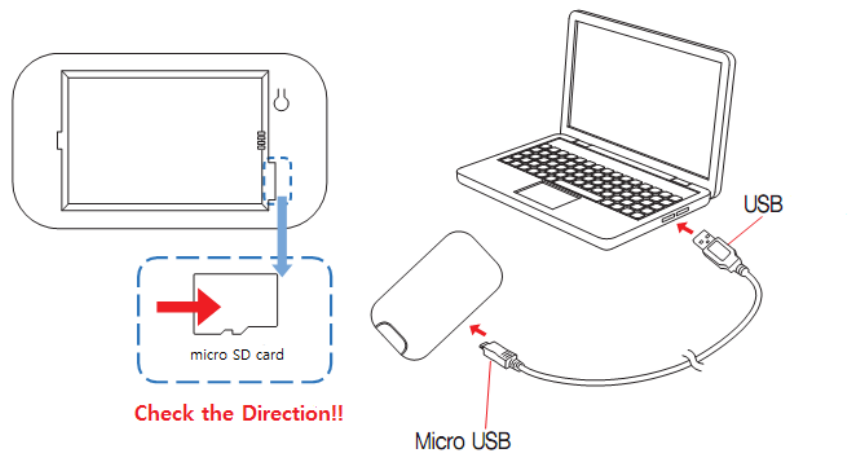
Micro SD Card
You can use the storage function by installing a micro SD card. When you connect the device
to a PC via USB cable after you insert a micro SD card, it is recognized as a removable disk
on your PC.
You can also use the media server (DLNA) and file transfer server (FTP) functions by
downloading related programs and apps on your PC or Smartphone. Some popular Media
Streaming apps are BubbleUPnP for Android devices and Gizmoot for iOS devices. And some
popular apps for FTP include File Manager and AndFTP for both Android and iOS devices.
The micro SD Card Slot is located under back cover, first remove back cover and then insert
micro SD Card into the upper slot.
Before insert micro SD Card, check the orientation of the card.
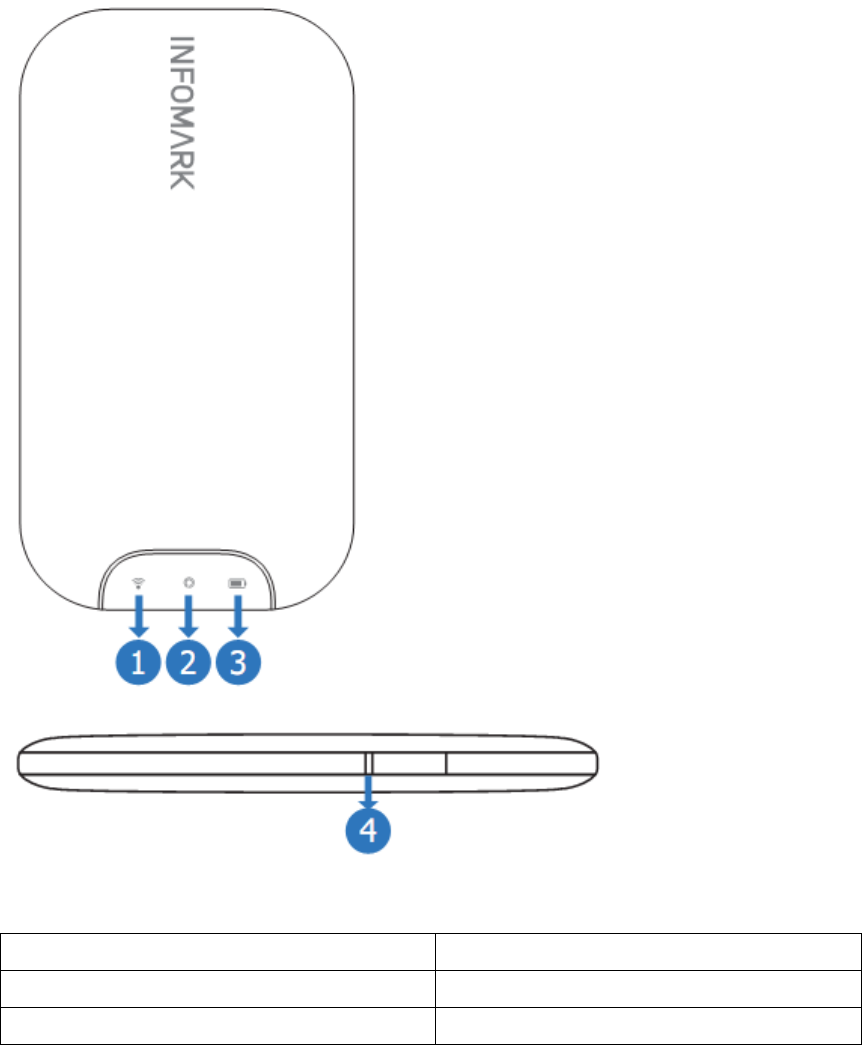
2.3) LED
Status LED Information
MyHotspot support 4 status LED( Wi-Fi, Network, Battery, External changing )
1. Wi-Fi Status LED
2. Network Status LED
3. Battery Status LED
4. External charging status LED
Wi-Fi status
Wi-Fi status is shown on Wi-Fi LED.
Wi-Fi On with Wi-Fi clients
LTE Network : Green (Solid)
Wi-Fi On without Wi-Fi clients
LTE Network : Green (Blinking)
Wi-Fi Off
LED Off
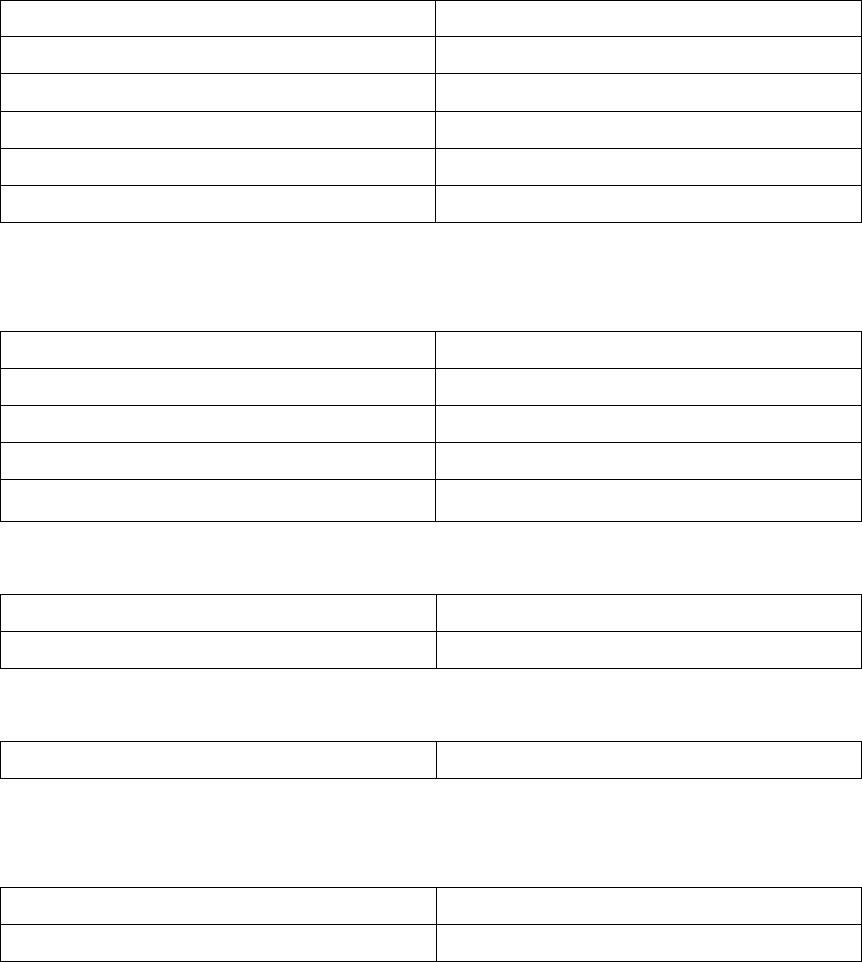
Network Status
LTE signal level is shown on Network LED.
No SIM Card
Purple (Blinking)
SIM Initial Fail or SIM Lock
Yellow (Blinking)
Connecting / Out of zone
Red (Blinking)
Low level
Red (Solid)
Middle level
Yellow (Solid)
High level
Green (Solid)
Battery Status
Battery status is shown on PWR LED.
20~ 0%
Red (Solid)
50~20%
Yellow (Solid)
100~50%
Green (Solid)
When charging with wall charger or USB cable
Red (Solid)
When battery is fully charged
Green (Solid )
Factory reset LED status
Wi-Fi LED
Green (Solid)
Network LED
Blue (Blinking)
Firmware updating LED status
Network LED
Blue (Blinking)
※ After downloading the update file, firmware update will start next booting.
External Charging status LED
External Charging cable is in Use
Red (Solid)
External Charging cable is Not in Use
LED Off
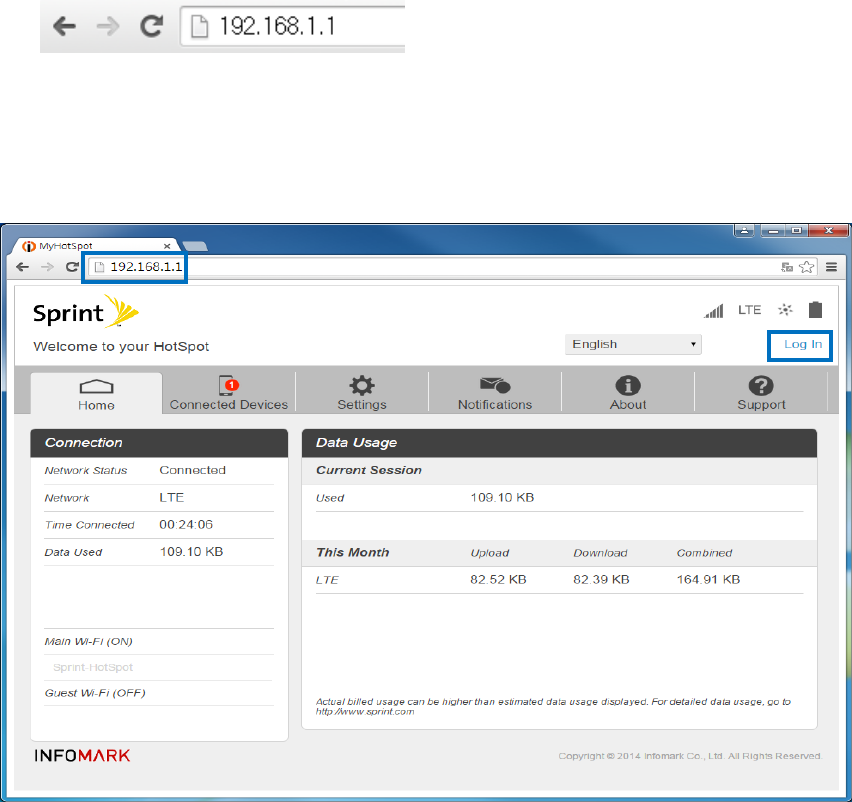
3. Web Management
3.1) How to Connect to Web Management Page
Connect to Web management page over PC
1. Connect PC to the device using Wi-Fi.
- Default Wi-Fi SSID is "IML-C4300Wa- xxxxxx".
"xxxxxx" is lower 6 Hex. Value of Wi-Fi MAC Address.
- Default Wi-Fi Key is "yyyyyyyy".
"yyyyyyyy" is Serial number(8 Digit).
2. Start Web browser on PC
- Use web browser to connect Web management page
- Type Address http://192.168.1.1
3. Log In
- Click Log In on main page to log in web management page.
- Enter the user password (password by default) in the log in window, and then click
Log In.
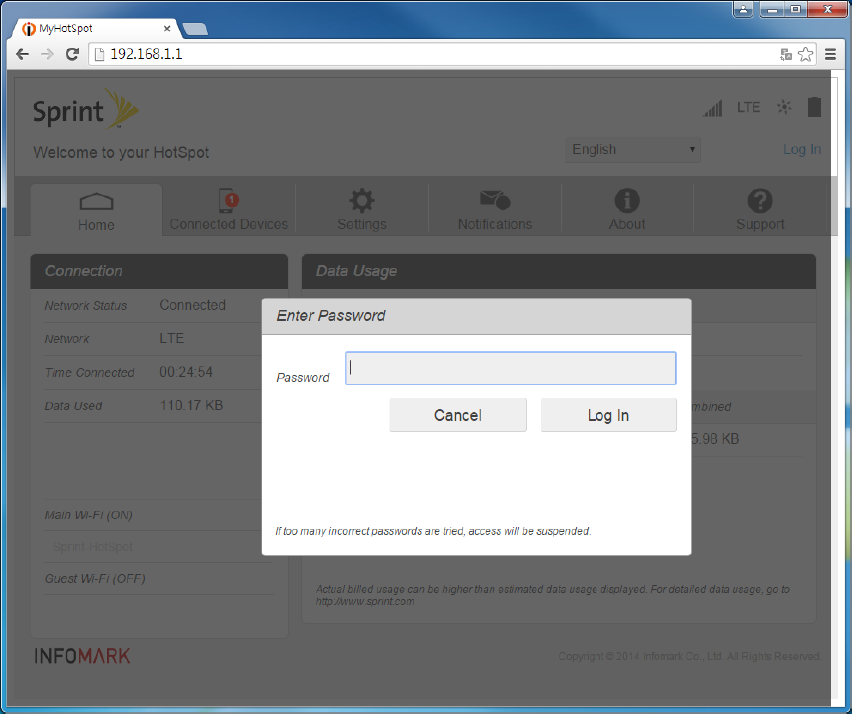
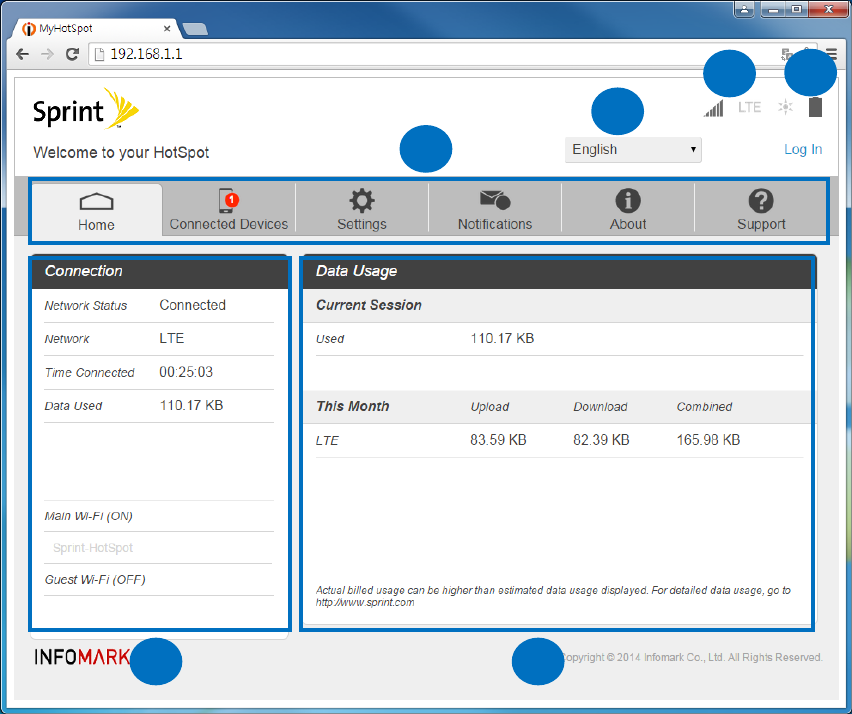
3.2) Web Management Page Menu
Web management page Display
1. Network Status: Display Signal Level(7 bars) , Current Network(LTE) and Usage
Indicator(star shape)
2. Battery Status: Display Battery Status and Charging status.
3. Language Setting: English(default)/Spanish
4. Main Menu.
5. Sub Menu & Status information.
6. Detailed information.
2
4
5
6
1
3
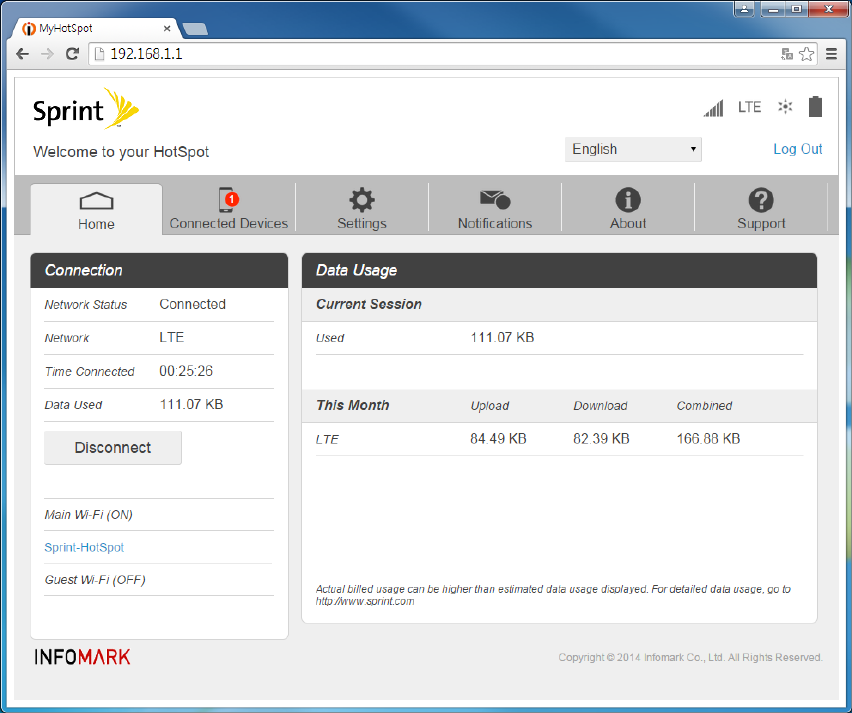
3.2.1) Home
Show connection information of LTE and Wi-Fi AP and data usage of the device.
1. CONNECTION
- Network Status : Connected / Not Connected / Connecting / Disconnecting
- Network : Show type of connected mobile network (LTE)
- Time Connected : Show elapsed time after mobile network connection
- Data Used: Show amount of data after mobile network connection.
- Connect Button: You can connect to or disconnect from mobile network.
- Main Wi-Fi : Show status of Main Wi-Fi and clients
- Guest Wi-Fi : Show status of Guest Wi-Fi and clients
2. Data Usage
- Current Session : Show amount of data used in current session
- This Month: Show amount of data used in this month.
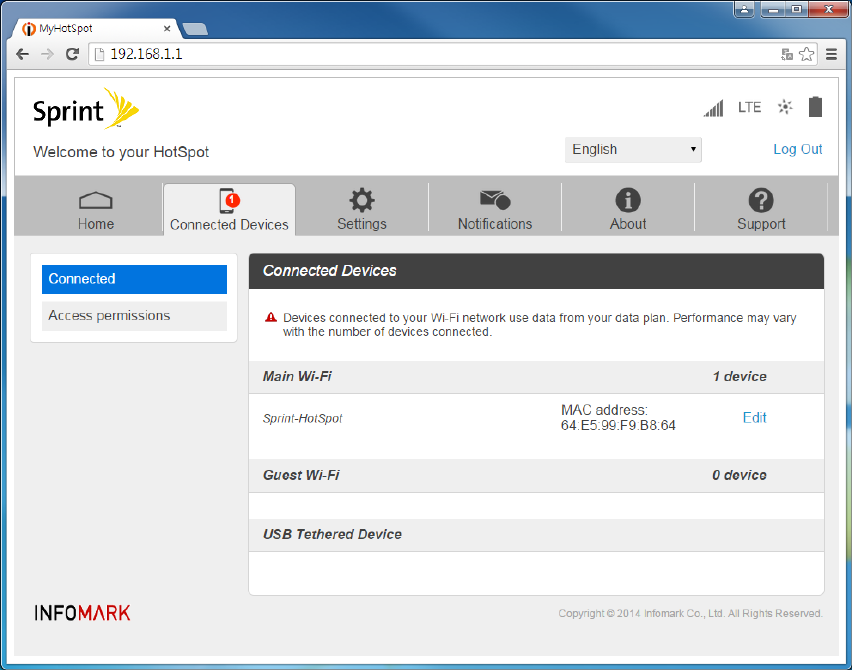
3.2.2) Connected Devices
1. Connected Devices
- Show connected clients through Main Wi-Fi, Guest Wi-Fi and USB Tethered device
- You can find the number of clients and the name or MAC address of each client. You
can change the name of the client by clicking Edit.
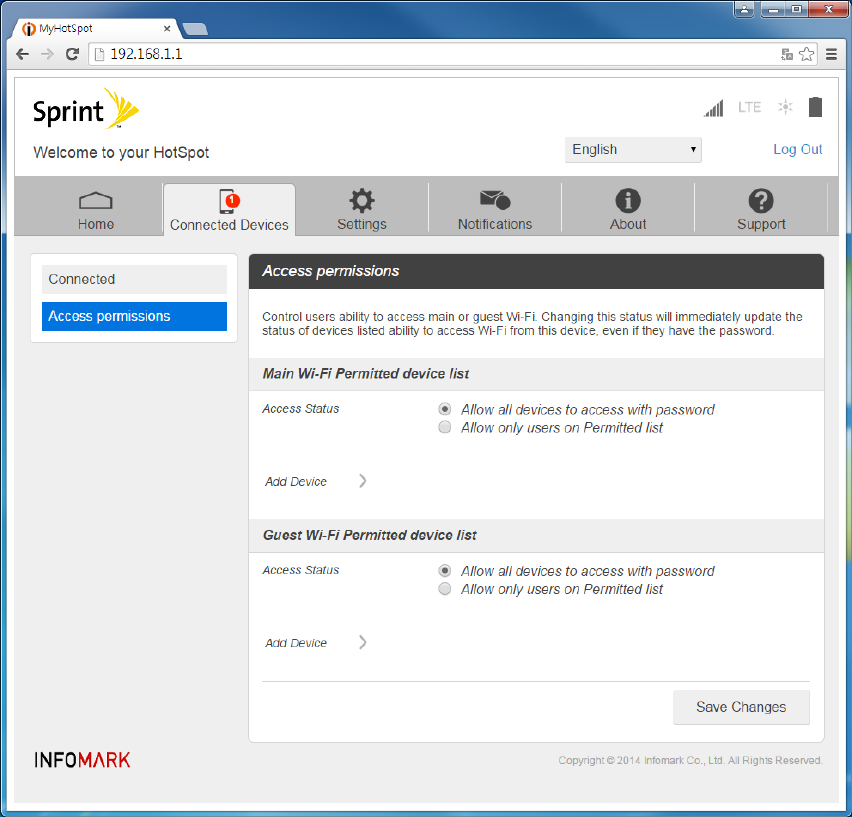
2. Access Permissions
- Show Access permission for clients in Main Wi-Fi and Guest Wi-Fi.
- Access Status: You can change the access permission for clients in Main Wi-Fi and
Guest Wi-Fi
'Allow all devices to access with password' - All the clients with correct password
can access the device.
'Allow only users on Permitted list' - Only the clients in Permitted list can access
the device.
- Add Device : You can add or remove clients to Permitted list
- Click Save Changes to save the configuration.
3.2.3) Settings
Wi-Fi
1. Wi-Fi Basic Settings
- Set Basic configuration of Main and Guest Wi-Fi.
- Multi SSID: Enable or disable the Guest Wi-Fi.
- Multi SSID isolation: Enable or disable the access between clients of Main Wi-Fi and
Guest Wi-Fi.
- Allow Guest Wi-Fi users to access the web interface: Enable or disable the web access
from Guest Wi-Fi.
- Wi-Fi Name: Set the SSID of Wi-Fi.
Tip: An SSID (Service Set Identifier) is a unique identifier that distinguishes one
hotspot from another. Wireless devices use the SSID to establish and maintain
wireless connectivity. You should make the SSID unique and change it on a regular
basis for optimal security
- Wi-Fi Password: Set the password for accessing the Wi-Fi hotspot.
※ Note: The password cannot contain special characters.
- Authentication Method
WPA/WPA2 PSK : Wi-Fi devices that use either WPA or WPA2 can connect to the
MyHotspot. Supported by most Wi-Fi devices.
WPA2-PSK: This is a stronger, newer security standard that is limited to newer Wi-
Fi devices.
None: No security is used (no password is required to access the Wi-Fi network);
this setting is not recommended. Anyone may access your device and use your
Internet connection.
- Encryption Method
Auto: Wi-Fi devices that use either TKIP or AES-CCMP can connect to the
MyHotspot. Supported by most Wi-Fi devices.
TKIP: This is an encryption standard that is supported by most Wi-Fi devices.
AES-CCMP: This is a stronger, newer encryption standard that is limited to newer
Wi-Fi devices.
- Privacy Separator: Enable or disable the privacy separator function.
- SSID Stealth
On: Prohibit the SSID from being broadcast.
Off: Enable the SSID to be broadcast.
- Maximum Connections: Set the number limit of Wi-Fi clients that can connect to the
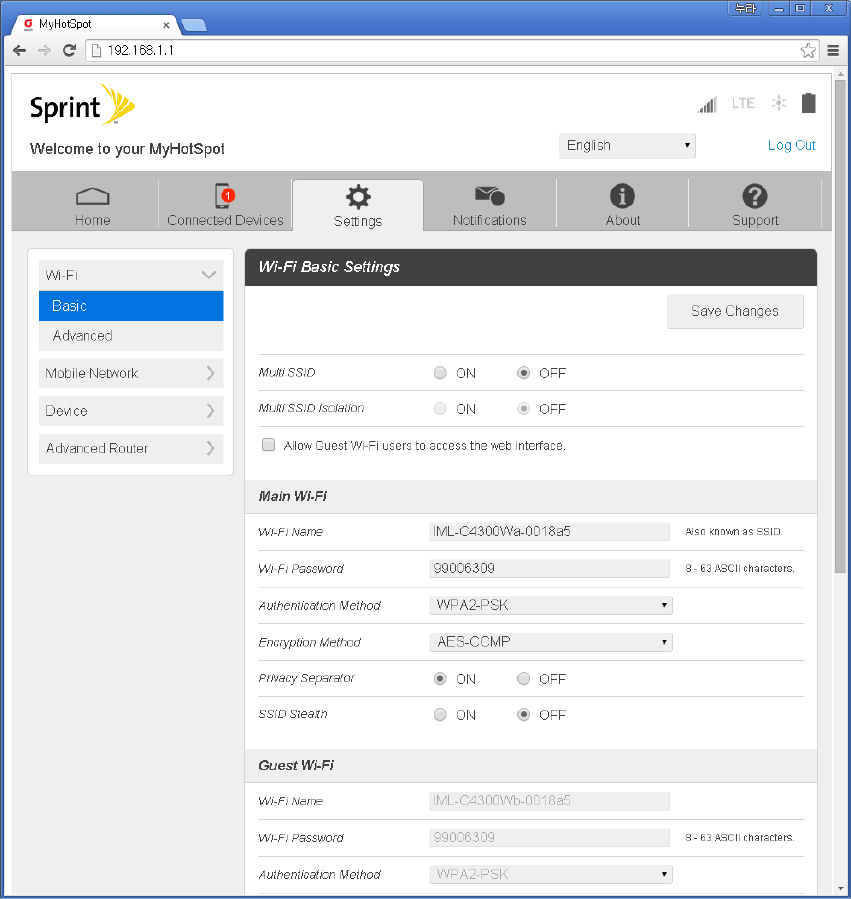
device. You can change the number limit of Main Wi-Fi and Guest Wi-Fi using arrow
button.
- Wi-Fi Settings Reset - Restore all Wi-Fi settings to the default values.
- Click Save Changes to save the configuration.
2. Wi-Fi Advanced Settings
- Set Advanced configuration of Wi-Fi.
- Country: Set the country.
- Wi-Fi Mode
2.4GHz 20MHz : Set the frequency to 2.4GHz and bandwidth to 20MHz
2.4GHz 40MHz : Set the frequency to 2.4GHz and bandwidth to 40MHz if
available
5GHz 20MHz : Set the frequency to 5GHz and bandwidth to 20MHz
5GHz 40MHz : Set the frequency to 5GHz and bandwidth to 40MHz if available
- Wi-Fi Channel
Auto : Device automatically determine the Wi-Fi channel to use
You can also select Wi-Fi channel manually.
2.4GHz : ch. 1~11
5GHz : ch. 36/40/44/48/149/153/157/161
- Tx Power : Set the transmit power of Wi-Fi
Long/Medium/Short: Long means higher power and Short means lower power.
- Click Save Changes to save the configuration.
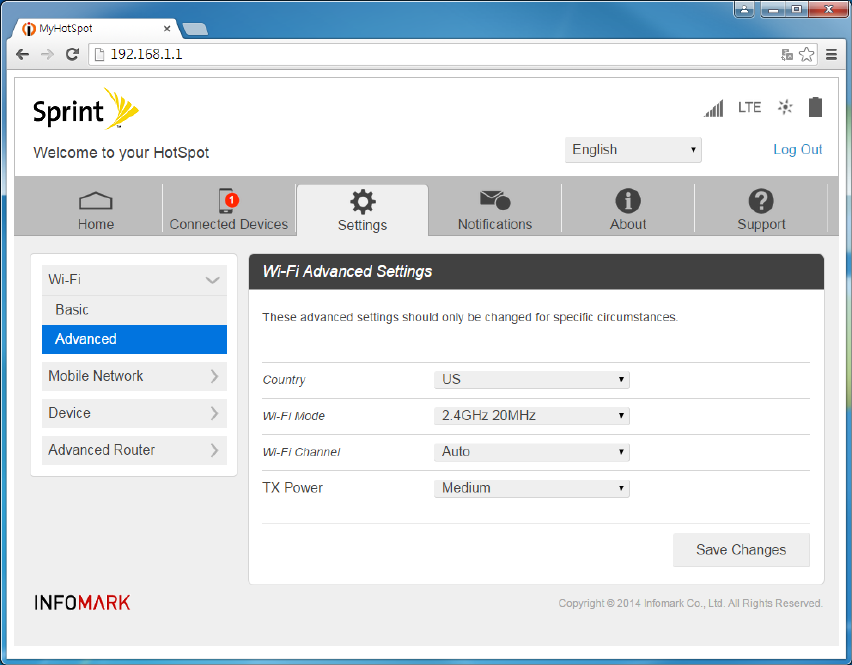
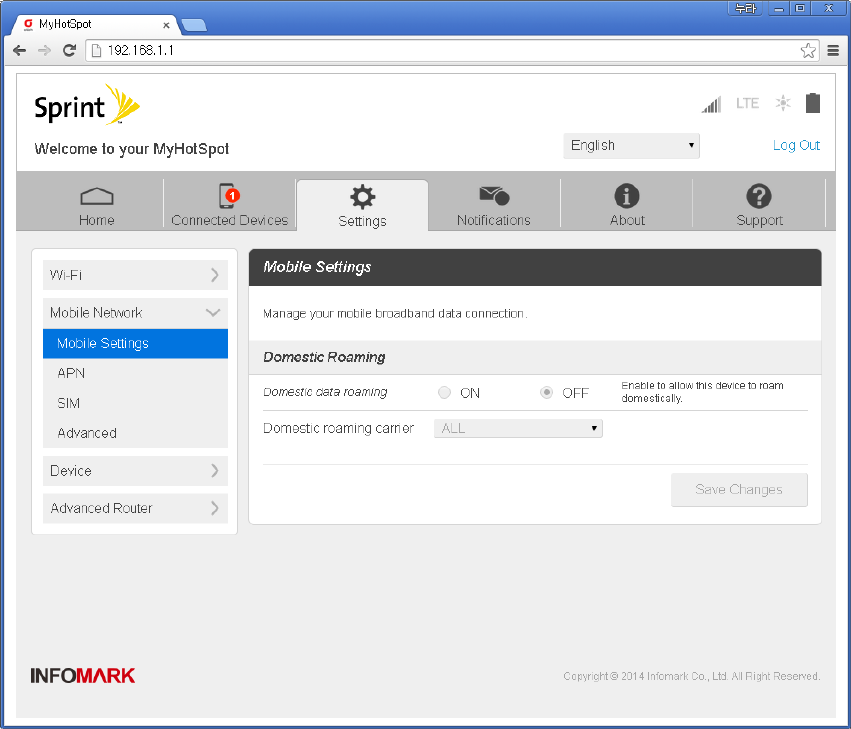
Mobile Network
1. Mobile Settings
- Domestic data roaming
On : Allow the device to roam domestically.
Off : Not allow the device to roam.
- Domestic roaming carrier
All : Allow the device to roam in all domestic partners.
MCC : 310 ~ 316
- Click Save Changes to save the configuration.
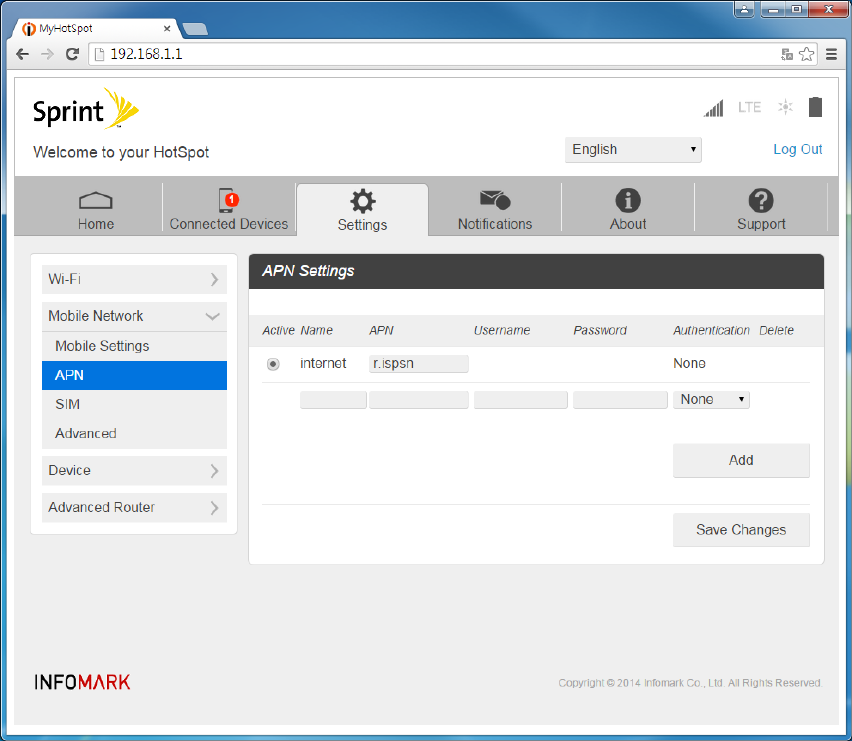
2. APN Settings
- You can change the APN(Access Point Name) for LTE data usage.
- Click Add to add a new APN setting
- Select active APN profile using Active radio box.
- Click Save Changes to save the configuration.
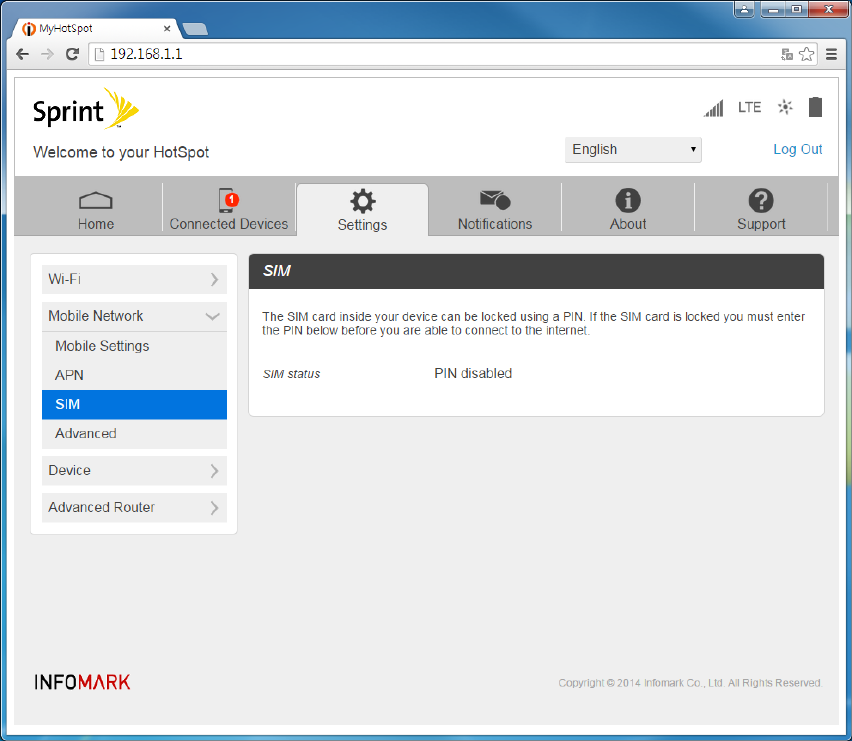
3. SIM
- SIM status : Show SIM card status
- You can verify SIM PIN/PUK when SIM is locked.
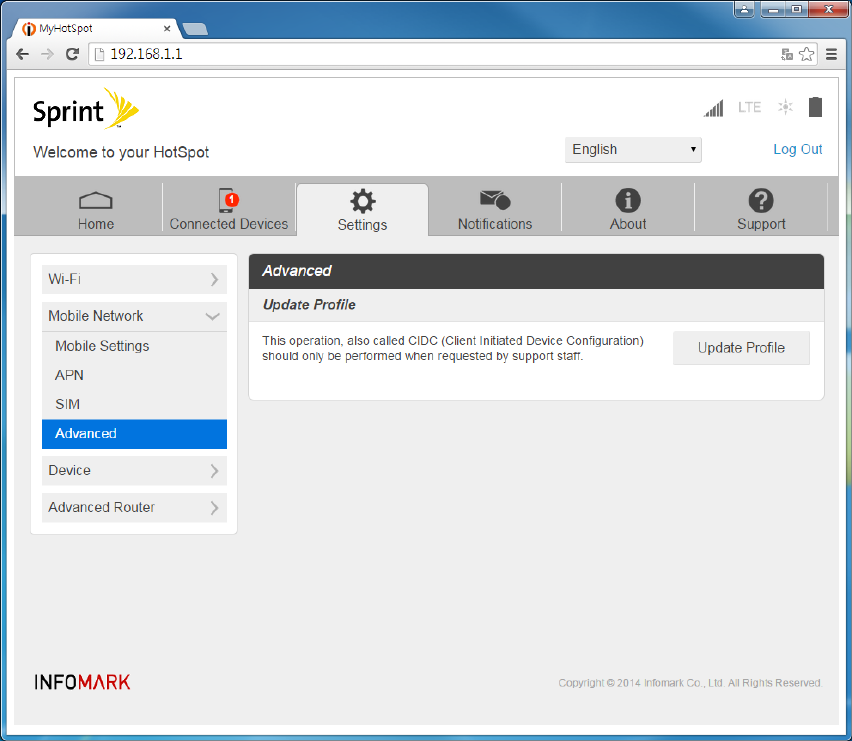
4. Advanced
- Update Profile: Update the configuration of the device through OMA-DM (Open Mobile
Alliance Device Management) server of your service provider.
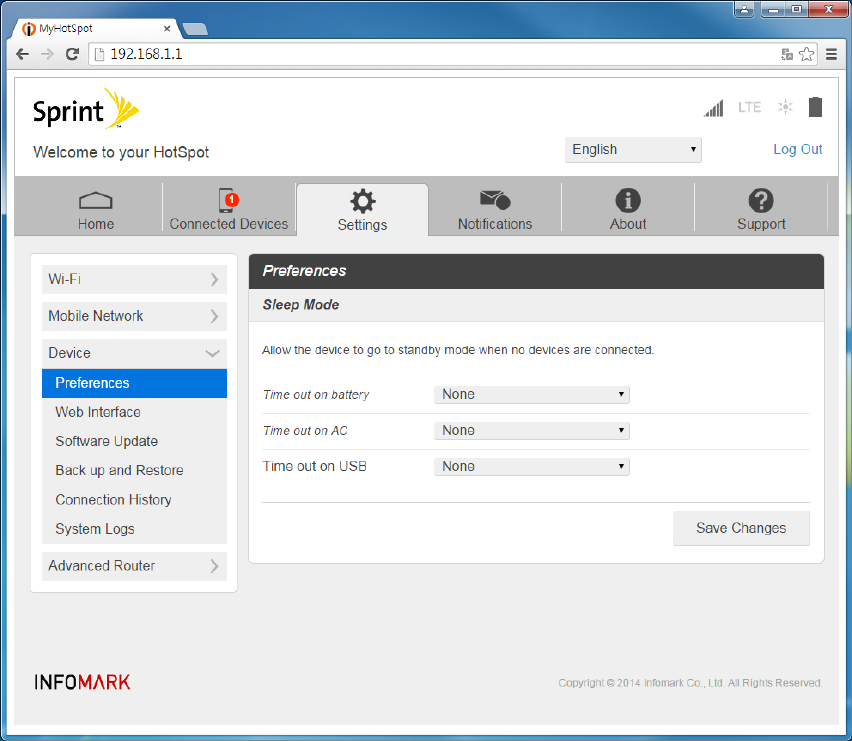
Device
1. Preference
- Sleep Mode can set how soon the device goes into power management mode when no
Wi-Fi clients are connected to it.
- Time out on battery - Set the time-before-sleep when device is on battery power.
- Time out on AC - Set the time-before-sleep when is connected to the AC adaptor
through the USB cable.
- Time out on USB - Set the time-before-sleep when device is connected to a computer
through the USB cable.
- Click Save Changes to save the configuration.
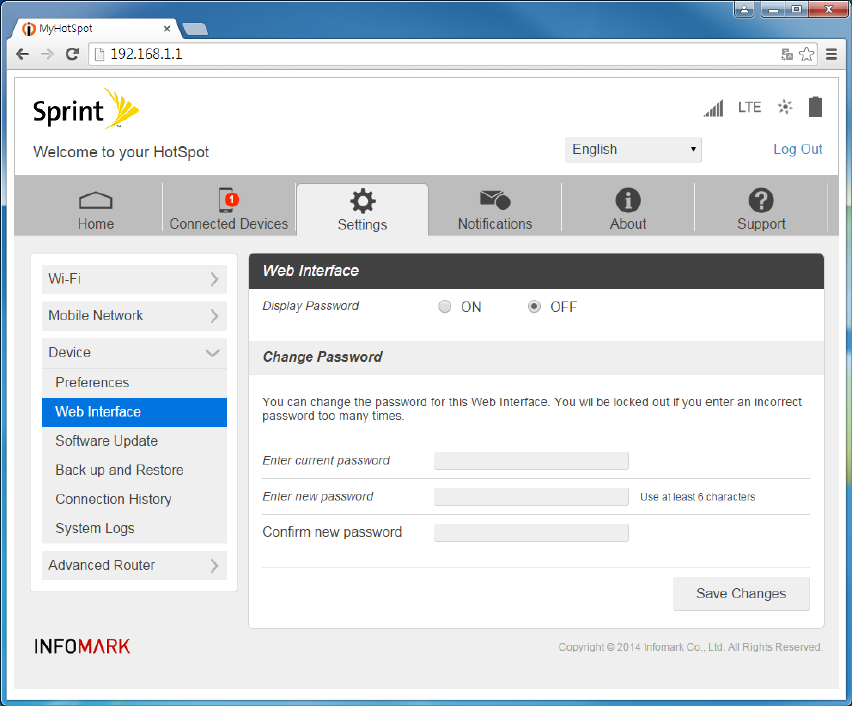
2. Web Interface
- Display Password: Show or Hide the password while changing the password.
- Change Password: Change the password of device's Web management page.
- Click Save Changes to save the configuration.
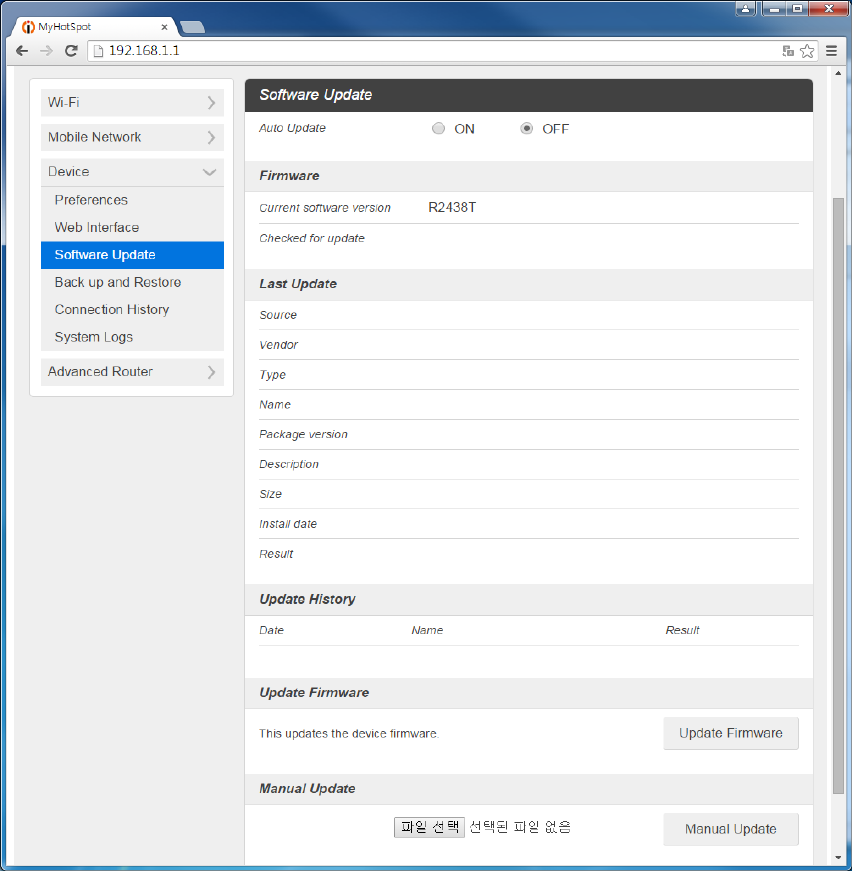
3. Software Update
- Show Software Information and perform software update.
- Auto Update : Enable or Disable automatic firmware update from remote server.
- Firmware : Show the version for the software and last date of update check.
- Last Update : Show the information about current software.
- Update History : Show software update history.
- Update Firmware - Update the firmware of the device through OMA-DM server of your
service provider.
- Manual Update: You can update the firmware using a file stored in PC. Choose the file
using Choose File and click Manual Update to proceed with manual firmware update.
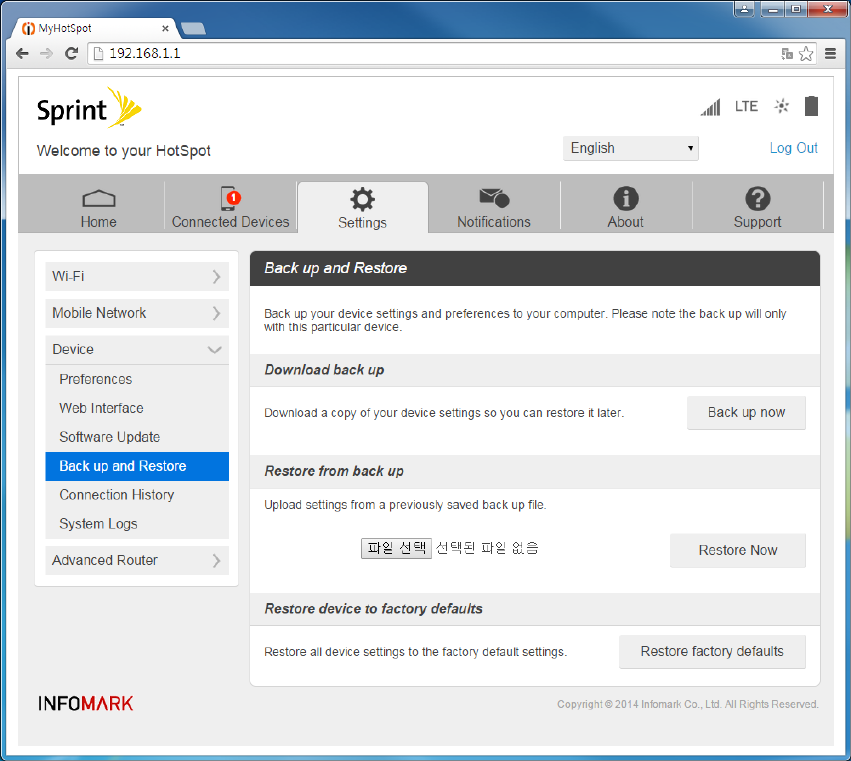
4. Backup and Restore
- Backup and Restore device settings
- Download backup: Click Backup Now to save the system configuration parameters in
the path you desired.
- Restore from backup: Click Choose file to select a file saved previously to restore.
Then click Restore Now to proceed with restoring.
- Restore device to factory defaults: Click Restore factory defaults to reset to the
factory default settings.
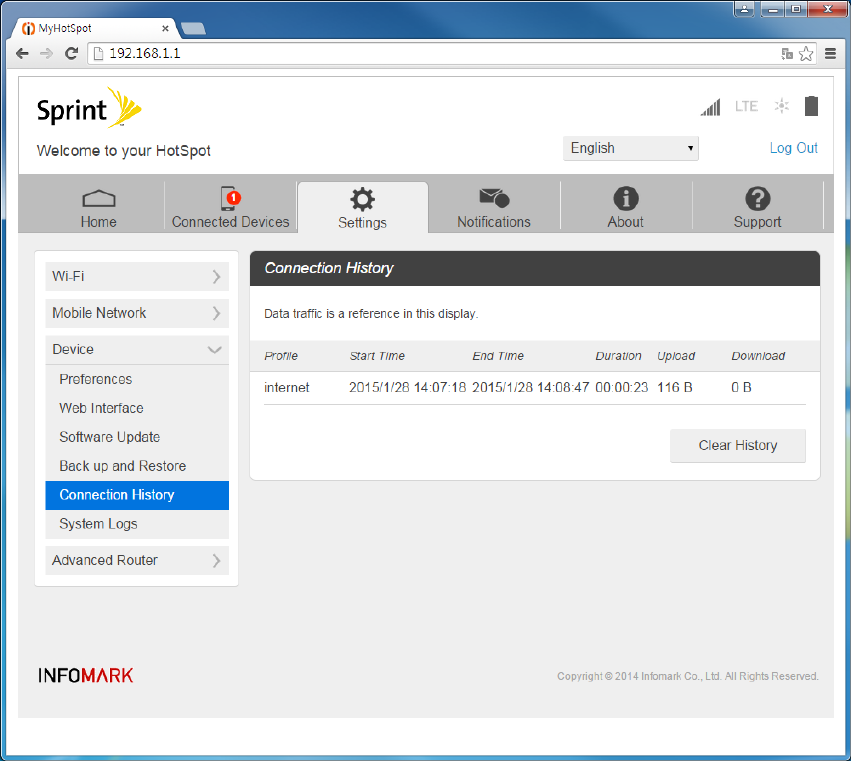
5. Connection History
- Show Data Connection History.
- Each record shows the profile name, start time, end time, duration, upload and
download traffic volume.
- Click Clear History to clear all the connection history.
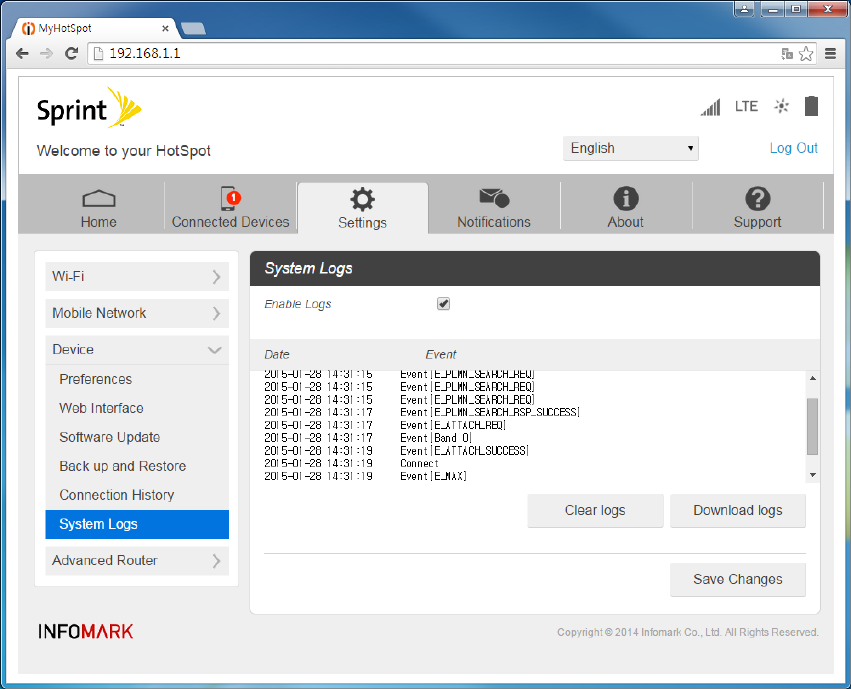
6. System Logs
- Show System Logs
- Each record shows the system events, such as connect, disconnect and other system
events.
- Enable Logs : Enable or disable logging system events
- Click Clear logs to clear current logs.
- Click Download logs to save logs into a PC.
- Click Save Changes to save the configuration.
Advanced Router
1. LAN Settings
- Set Advanced LAN parameters such as IP, DHCP, DNS.
- IP address: Set the IP address of the device.
- Subnet mask: Set the subnet mask of the device.
- VPN pass-through: Enable or Disable the VPN pass-through function.
- DHCP Server: Enable or Disable DHCP server function. When DHCP server is enabled,
the device provides the TCP/IP configuration automatically for the LNA clients that
support DHCP client capability. If DHCP server is disabled, each client must be
configured manually.
- DHCP IP range: Set the range of IP address pool assigned to DHCP clients.
- DHCP lease time: Set the lease time of the IP address.
- DNS manual mode: You can set the address of DNS manually when it is on
- Click Save Changes to save the configuration.
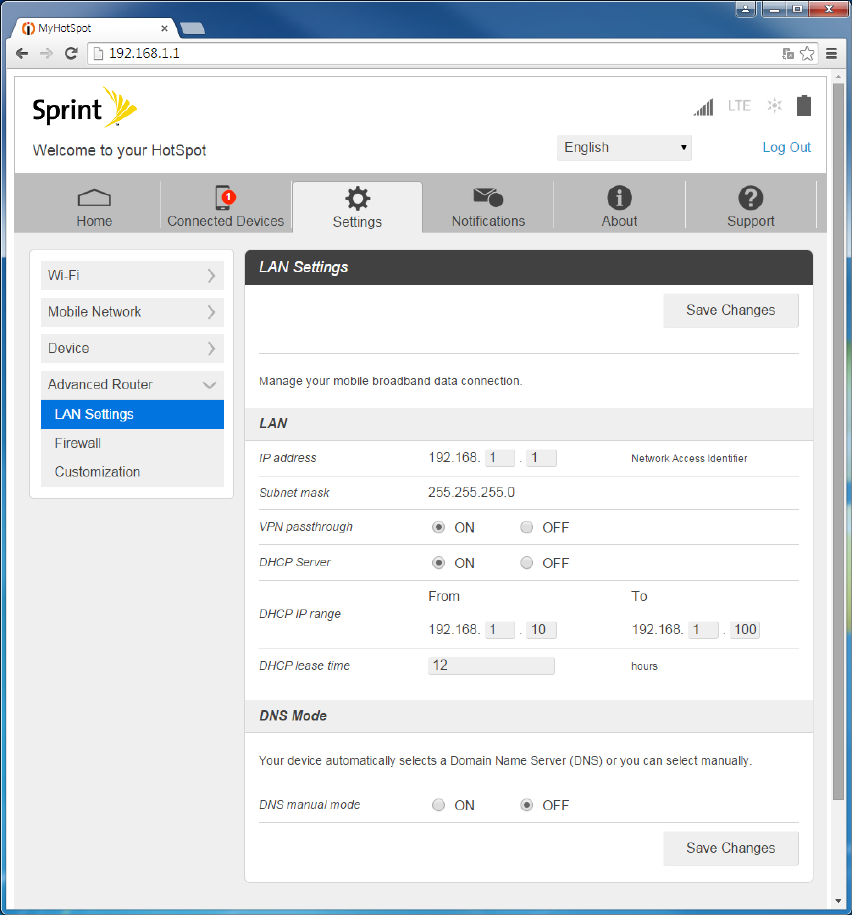
2. Firewall
- The firewall is designed to permit or deny network transmissions based upon a set of
rules and is frequently used to protect networks from unauthorized or unverified access
while permitting legitimate communications to pass.
- Firewall Switch: Enable or disable Firewall (main switch of the firewall).
- Enable ping from Internet : Enable or disable response to ping request from Internet.
- When the firewall feature is enabled, you can use the IP incoming filter to receive
certain specified IP packets on the WAN side.
- IP Address Filtering: Enable or disable IP address Filtering.
You can add or remove a filtering rule which include LAN IP address, Protocol,
LAN port and Policy.
- Portmapping allows you to direct incoming traffic from the Internet (identified by
protocol and external port) to an internal server with a private IP address on the LAN.
- Portmapping: Enable or disable Portmapping.
You can add or remove a portmapping rule which includes name, WAN port, LAN
IP address, LAN port, Protocol and Enablement.
- Click Save Changes to save the configuration.
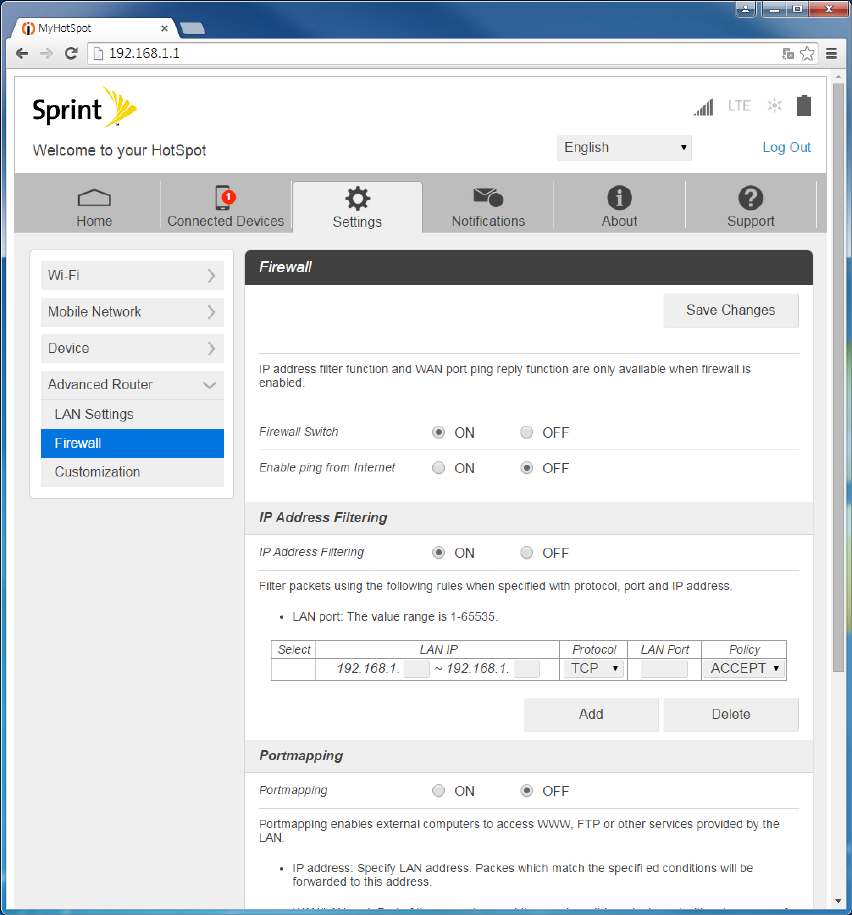
3. Customization
- UPnP (Universal Plug and Play) is a set of networking protocols that allow UPnP
devices on a network to detect each other and connect with each other seamlessly and
automatically, and establish functional network services for data sharing,
communication, and entertainment. Simply, UPnP allows automatic discovery and
configuration of devices attached to your LAN.
- UPnP setting : Enable or disable the UPnP function.
- SD Card : Show status of SD card.
- DLNA is an industry-wide standard for sharing multimedia data over a local network.
DLNA server enables you stream Video and Audio in sdcard to DLNA compliant clients.
- DLNA Status : Show DLNA server status.
- DLAN Setting : Enable or disable DLNA server.
- FTP Status : Show FTP server status.
- FTP link : Show a link of FTP server browsers can open.
- FTP Setting : Enable or Disable FTP server.
- Click Save Changes to save the configuration.
※ Account information for FTP - ID : “user” and Password : same as Web password
(“password” by default)
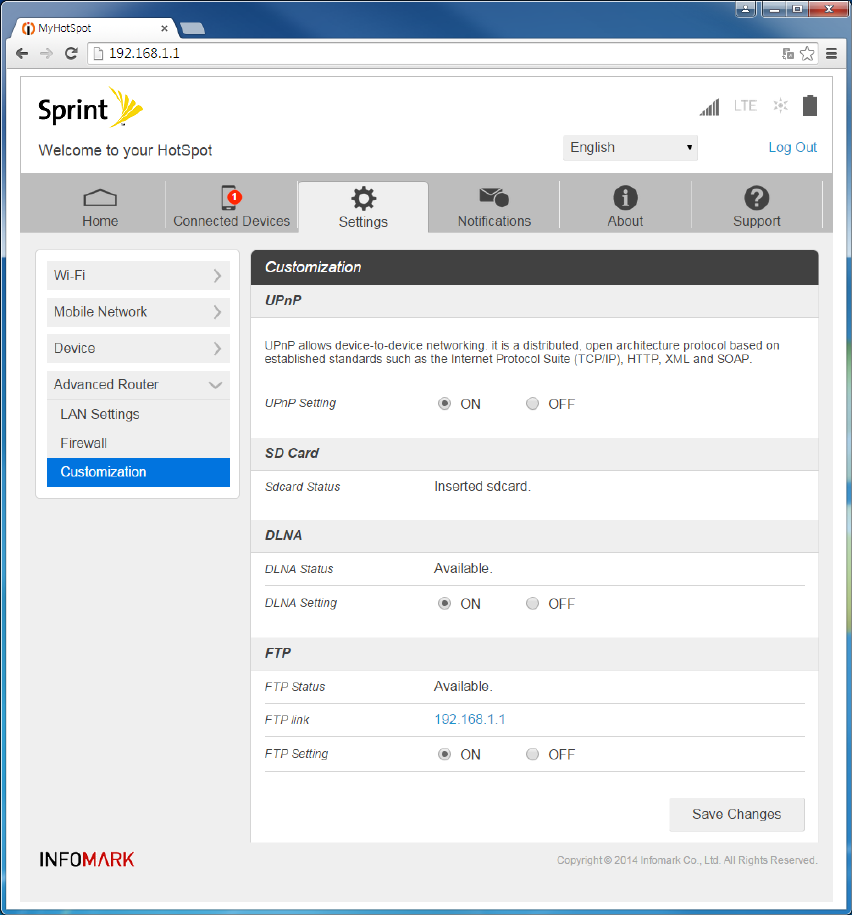
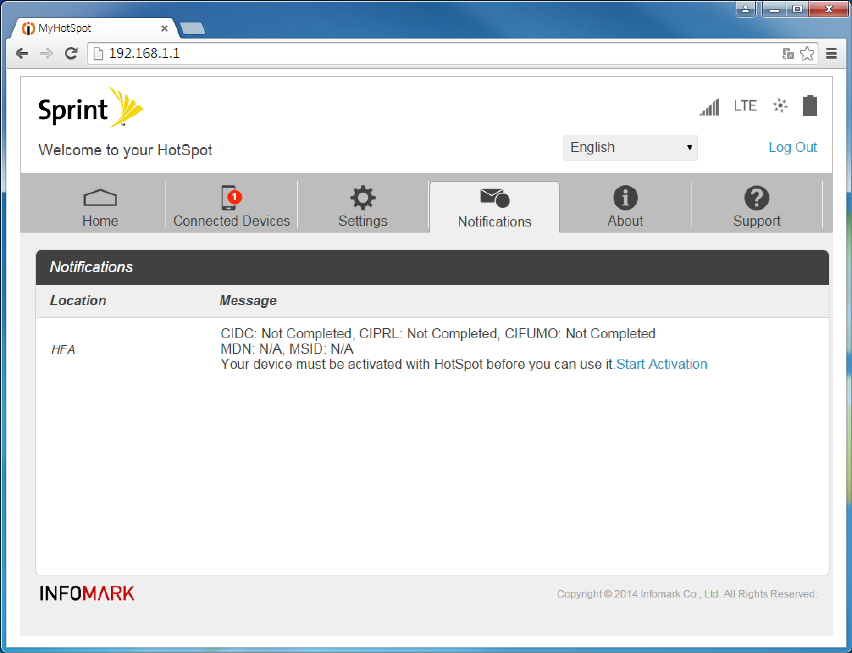
3.2.4) Notifications
Show Notifications on the device.
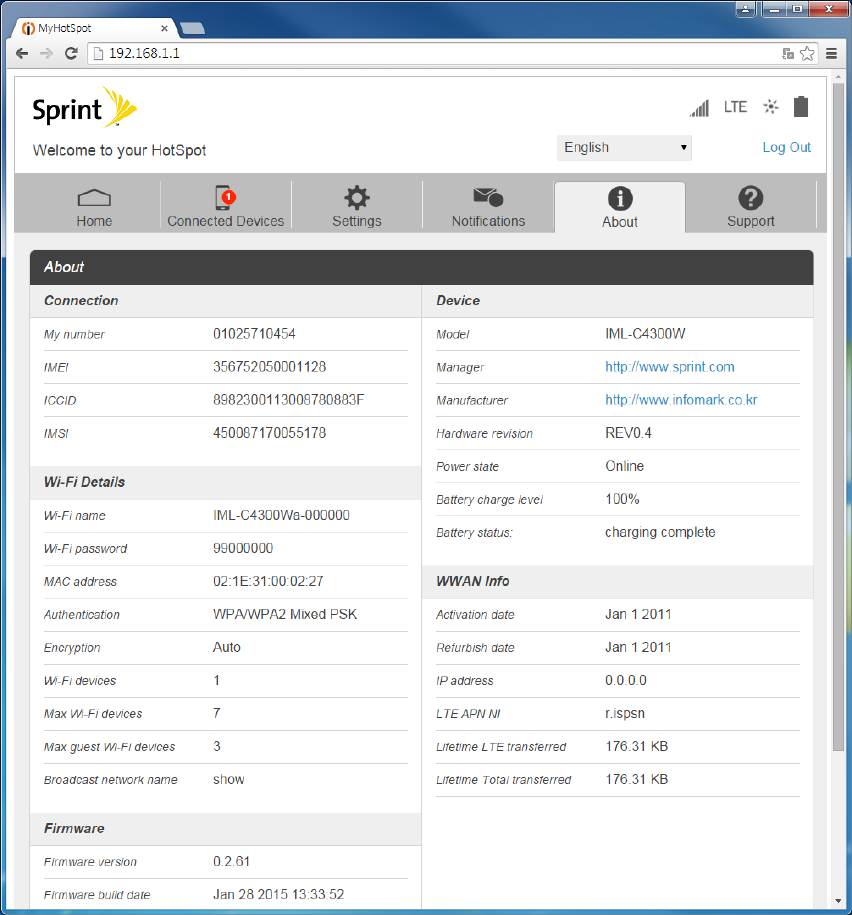
3.2.5) About
Show information about the device.
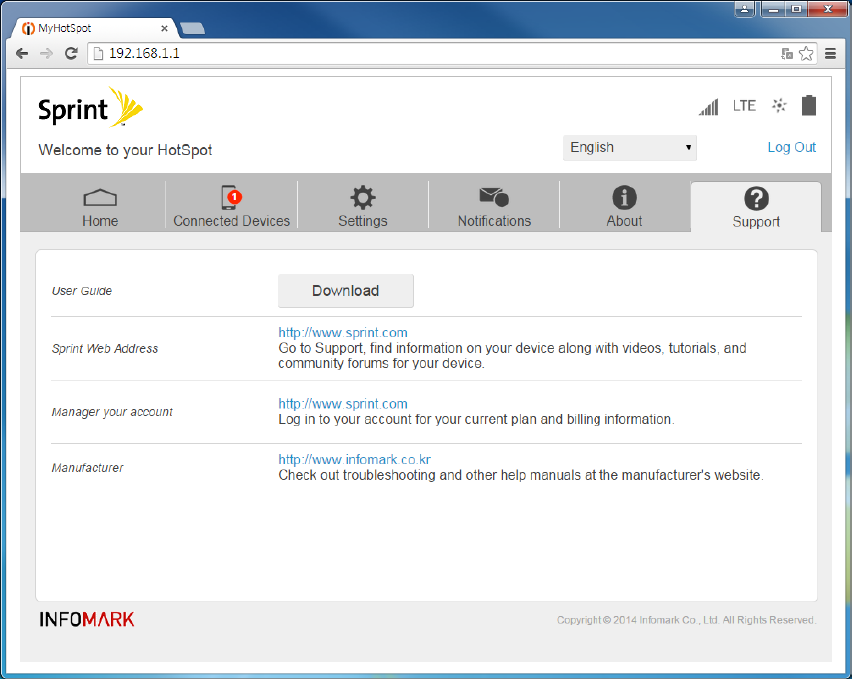
3.2.6) Support
Show device Support Information.
4. Frequently Asked Questions
How can I tell the device is working after power up?
1. Check LEDs on the front side. Below is for normal operation.
Wi-Fi Status LED - Green (solid or blink)
Network Status LED - Green, Yellow or Red (solid)
Battery Status LED - Green, Yellow or Red (solid)
2. If the device does not power up, please charge it first and try again.
3. If the device does not power up after charging, please contact customer service.
How can I tell I'm connected to LTE?
1. Check Network Status LED on the front side. If it’s connected to LTE, it will show either
solid green or yellow. If it shows solid red, it means LTE service is not available.
2. Check your notebook or Smartphone to verify if internet service is available.
3. Check Web Management page if it is connected to the LTE Network
How do I connect to Wi-Fi?
1. Windows XP : Control panel -> Network Connection -> View Available Wireless Networks
-> check IML-C4300W and connect
2. Windows Vista /Windows 7 : Control panel -> Network and Internet -> View network
status and tasks -> Connect to a network -> check IML-C4300W and connect
3. Windows 8 : Settings -> select wireless icon -> check IML-C4300W and connect
4. Smartphones : Settings -> Wi-Fi -> check IML-C4300W and connect
What do I do if I forget the Main or Guest Wi-Fi password?
Check "Device factory Reset" on the manual
What do I do if I forget the Administrator password?
Check "Device factory Reset" on the manual

5. Technical Specification
5.1) Radio Frequency specification
LTE
Standard : LTE Rel9 Cat4
Frequency Band :
- B25 (FDD) : 1850-1915 MHz
- B26 (FDD): 814-849 MHz
- B41 (TDD): 2496-2690 MHz
Air Interface : Internal Antenna
Max output power : 23dBm
Wi-Fi
Standard : IEEE802.11 a/b/g/n
Frequency :
- 2.4GHz : 2412 ~ 2462MHz
- 5GHz : 5180MHz ~ 5240MHz, 5745MHz ~ 5825MHz
Air Interface : Internal Antenna
Bandwidth : HT20/HT40
MIMO : 2TX2RX support (Default 1T1R)
SSID : Multiple-SSID support(2 SSID)
5.2) Electrical and Mechanical specification
Operating Voltage
Internal Battery - Nor. 3.8V (min 3.3V/max 4.35V)
Battery (Li-Ion)
3.8V / 2,420mAh
Wall charger
5V/1A
Dimension
104.0 x 59.0 x 11.5mm
Weight
87g
6. Safety Information
Read important safety information about your device.
6.1) Important Notice
Due to the nature of wireless communications, transmission and reception of data can never be
guaranteed. Data may be delayed, corrupted (i.e., have errors) or be totally lost. Although
significant delays or losses of data are rare when wireless devices such as the INFOMARK
MyHotspot are used in a normal manner with a well-constructed network, your device should
not be used in situations where failure to transmit or receive data could result in damage of any
kind to the user or any other party, including but not limited to personal injury, death, or loss of
property. INFOMARK accepts no responsibility for damages of any kind resulting from delays or
errors in data transmitted or received using your device, or for failure of your device to transmit
or receive such data.
6.2) Safety and Hazards
Do not operate your device under the following conditions.
● In areas where blasting is in progress
● Where explosive atmospheres may be present
● Near medical equipment
● Near life support equipment, or any equipment that may be susceptible to any form of radio
interference.
In such areas, your device MUST BE POWERED OFF. Your device can transmit signals that
could interfere with this equipment.
Do not operate your device in any aircraft, whether the aircraft is on the ground or in flight. In
aircraft, your device MUST BE POWERED OFF. When operating, your device can transmit
signals that could interfere with various onboard systems.
※ Note: Some airlines may permit the use of cellular phones while the aircraft is on the ground
and the door is open. Your device may be used at this time.
The driver or operator of any vehicle should not operate the device while in control of a vehicle.
Doing so will detract from the driver or operator’s control and operation of that vehicle. In some
jurisdictions, operating such communications devices while in control of a vehicle is an offense.
6.3) Proper Battery Use and Disposal
Follow these guidelines to ensure safe and responsible battery use.
● Do not open, disassemble, puncture, crush, bend, or shred.
● Do not expose to water or other liquids, fire, explosion, or other hazards.
● Use the battery only in the INFOMARK MyHotspot.
● If using with a charger, use only the AC charger supplied with your device.
● Do not short circuit the battery.
● When replacing a battery, use the same model of battery that was supplied with your device.
● Follow local regulations when disposing of a used battery.
● Avoid dropping your device or the battery. If dropped and you suspect damage, take it to a
service center for inspection.
※ Note: Improper battery use may result in a fire, explosion, or other hazard.
6.4) For Your Safety
Follow the precautions below for your safety.
Keep away from high humidity.
Use in clean place.
Place on a stable platform to avoid dropping.
Don’t keep around electromagnetic waves.
Don’t place on heavy things.
Don’t expose to direct sunlight.
Don’t throw to avoid breakage.
Don’t place on hot object.
Keep away from pets and children.
Keep away from water.
Don’t hold power adaptor with wet hands.
Avoid extreme temperatures.
Don’t dispose of your phone in fire.
7. Regulatory Notice
This section contains regulatory information for your device.
The design of the INFOMARK MyHotspot complies with U.S. Federal Communications
Commission (FCC) guidelines respecting safety levels of radio frequency (RF) exposure for
mobile devices, which in turn are consistent with the following safety standards previously set by
U.S. and international standards bodies:
● ANSI / IEEE C95.1-1999, IEEE Standard for Safety Levels with Respect to Human Exposure
to Radio Frequency Electromagnetic Fields, 3kHz to 300 GHz
● National Council on Radiation Protection and Measurements (NCRP) Report 86, 1986,
Biological Effects and Exposure Criteria for Radio Frequency Electromagnetic Fields
● International Commission on Non-Ionizing Radiation Protection (ICNIRP) 1998, Guidelines
for limiting exposure to time-varying electric, magnetic, and electromagnetic fields (up to 300
GHz)
FCC ID: YCO-IML-C4300W
RF Exposure - The INFOMARK MyHotspot has been tested for compliance with FCC RF
exposure limits in a portable configuration. At least 1.0 cm of separation distance between the
INFOMARK MyHotspot and the user’s body must be maintained at all times. This device must
not be used with any other antenna or transmitter that has not been approved to operate in
conjunction with this device.
WARNING (EMI) - United States FCC Information - This equipment has been tested and found
to comply with the limits for a Class B computing device peripheral, pursuant to Part 15 of the
FCC rules. These limits are designed to provide reasonable protection against harmful
interference in a residential installation.
This equipment generates, uses, and can radiate radio frequency energy and, if not installed
and used in accordance with the instructions, may cause harmful interference to radio
communications. However, there is no guarantee that interference will not occur in a particular
installation.
If this equipment does cause harmful interference to radio or television reception, which can be
determined by turning the equipment off and on, the user is encouraged to try to correct the
interference by one or more of the following measures:
● Reorient or relocate the receiving antenna.
● Increase the separation between the equipment and receiver.
● Connect the equipment into an outlet on a circuit different from that to which the receiver is
connected.
● Consult the dealer or an experienced radio/TV technician for help.
CAUTION: Any changes or modifications not expressly approved by INFOMARK could void the
user’s authority to operate the equipment.
This device complies with Parts 15, 24, and 27 of the FCC Rules. Operation is subject to the
following two conditions: (1) This device may not cause harmful interference, and (2) this device
must accept any interference received, including interference that may cause undesired
operation.
Use only the supplied antenna. Use of unauthorized antennas, or modifications, could impair
call quality, damage the phone, void your warranty, or result in a violation of FCC regulations.
Do not use the phone with a damaged antenna. A damaged antenna in contact with the skin
could cause a singe. Contact your local dealer for an antenna replacement.
8. Warranty Information
8.1) TBD